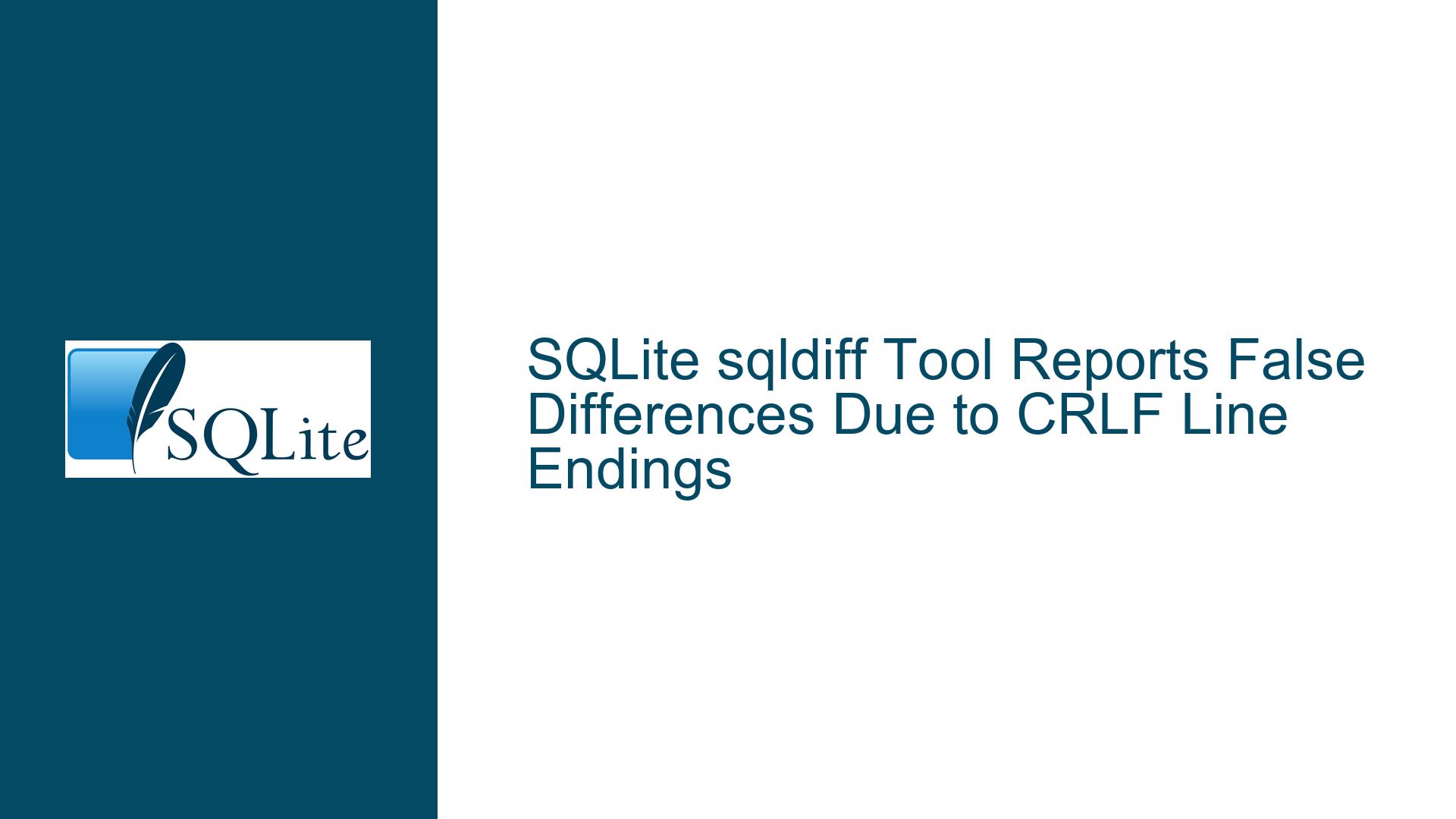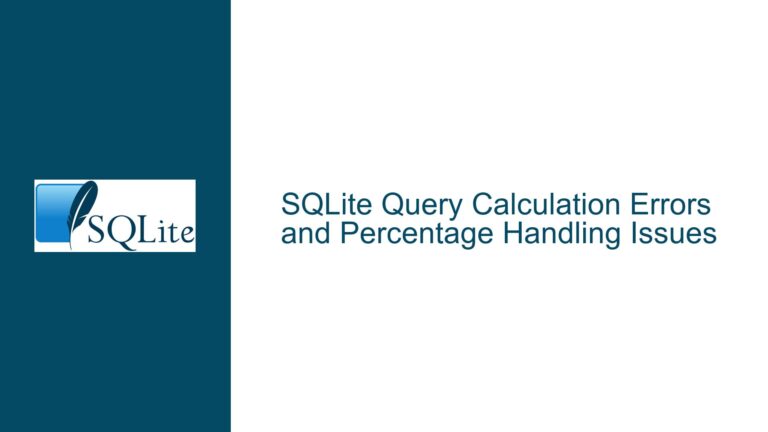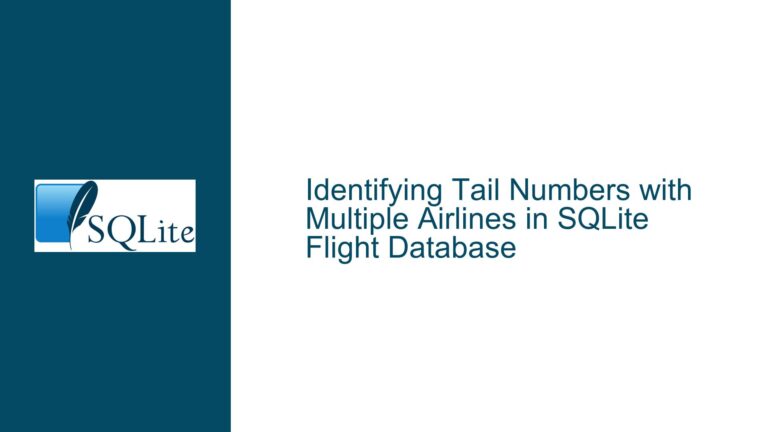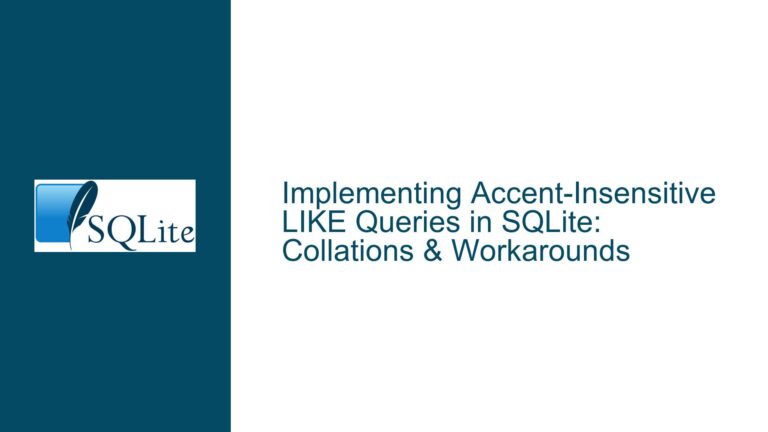SQLite sqldiff Tool Reports False Differences Due to CRLF Line Endings
Text Column Discrepancies in SQLite Diff Tool Despite Identical Databases
Issue Overview: CRLF vs. LF Line Endings Cause Persistent sqldiff Output
The SQLite sqldiff utility is designed to generate SQL statements that synchronize two databases. However, in environments where text columns contain newline characters (specifically CRLF vs. LF), users may observe recurring UPDATE statements even after applying the generated SQL to the backup database. This occurs because sqldiff detects differences in line endings (CRLF in the source database vs. LF in the backup or vice versa) that are not visually apparent in standard text editors. The root cause lies in how line endings are stored, compared, and propagated during the diffing process.
The problem manifests as follows:
- A text column in the source database contains CRLF (
\r\n) line endings. - The backup database, after applying
sqldiffoutput, inadvertently converts these to LF (\n) or retains CRLF inconsistently. - Subsequent
sqldiffruns continue to flag the same rows as requiring updates, leading to redundant SQL output.
This behavior stems from SQLite’s byte-for-byte comparison of text values. CRLF and LF are treated as distinct sequences, causing sqldiff to report differences even when the human-readable text appears identical. The issue is exacerbated when applications (e.g., UWP apps) enforce platform-specific line endings or when SQL execution environments alter line endings during script processing.
Possible Causes: Encoding Mismatches and Execution Environment Artifacts
1. Text Encoding Ambiguity in SQLite Columns
SQLite does not enforce column-level encoding; it stores text as UTF-8, UTF-16LE, or UTF-16BE, depending on the database encoding. If the source and backup databases use different encodings, line endings may be represented inconsistently. For example:
- UTF-8 represents CRLF as
0x0D 0x0A. - UTF-16LE represents CRLF as
0x0D 00 0A 00.
If the backup process converts text to a different encoding, CRLF sequences may not round-trip correctly, leading tosqldiffdiscrepancies.
2. Line Ending Normalization During SQL Script Execution
When sqldiff generates an UPDATE statement like:
UPDATE "Test Table" SET "Test Text"='THIS TEXT
CONTAINS SOME NEW LINES' WHERE rowid=3;
The newlines in the SQL string are interpreted according to the execution environment. For example:
- Command-line tools (e.g.,
sqlite3.exeon Windows) may convert LF to CRLF when reading SQL scripts. - Script editors (e.g., Notepad++) may normalize line endings when saving the script.
This can result in the backup database storing LF instead of CRLF (or vice versa), perpetuating the diff cycle.
3. Application-Level Line Ending Handling
Applications that write to the source database may inadvertently modify line endings. For instance:
- UWP text controls normalize CRLF to LF when saving to the database.
- Middleware or ORM layers (e.g., Entity Framework) may apply platform-specific line endings.
If the backup process does not replicate this normalization,sqldiffwill detect phantom differences.
Troubleshooting Steps, Solutions & Fixes: Normalization and Binary Validation
Step 1: Validate Text Encoding and Line Endings at the Binary Level
Action: Execute the following query on both databases to inspect the raw bytes of the problematic column:
SELECT hex("Test Text") FROM "Test Table" WHERE rowid=3;
Analysis:
- CRLF appears as
0D0Ain UTF-8 or0D000A00in UTF-16LE. - LF appears as
0Ain UTF-8 or0A00in UTF-16LE.
If the source and backup show different hex values for the same text, line ending normalization is occurring somewhere in the workflow.
Solution:
- Ensure both databases use the same text encoding (e.g., UTF-8). Use
PRAGMA encoding;to check. - Rebuild the backup database with the correct encoding if necessary:
ATTACH DATABASE 'backup.db' AS backup KEY 'secret'; PRAGMA backup.encoding = 'UTF-8';
Step 2: Audit SQL Script Execution for Line Ending Modifications
Action: Capture the sqldiff output to a file and inspect it with a hex editor (e.g., HxD on Windows):
sqldiff.exe source.db backup.db > diff.sql
Analysis:
- Verify that CRLF sequences (
0D0A) in theUPDATEstatements match the source database. - If the script contains LF (
0A) instead of CRLF, the execution environment (e.g., shell redirection) is altering line endings.
Solution:
- Use binary-safe methods to apply the SQL script. For example, in the SQLite CLI:
sqlite3 backup.db < diff.sql - Disable automatic line ending conversion in text editors or script runners. For PowerShell:
Get-Content diff.sql | Out-File -Encoding ASCII -NoNewline | sqlite3 backup.db
Step 3: Implement Line Ending Normalization in the Application Layer
Action: Modify the application writing to the source database to normalize line endings before insertion. For example, in C#:
string userText = textBox.Text.Replace("\r\n", "\n"); // Normalize to LF
Analysis:
- Consistent line endings (either CRLF or LF) prevent
sqldifffrom detecting differences. - Choose LF for cross-platform compatibility or CRLF for Windows-centric environments.
Solution:
- Add a database trigger to normalize line endings on
INSERTorUPDATE:CREATE TRIGGER normalize_line_endings BEFORE INSERT ON "Test Table" BEGIN SELECT NEW."Test Text" = REPLACE(NEW."Test Text", '\r\n', '\n'); END;
Final Recommendation:
Update to SQLite version 3.36.0 or later, where sqldiff explicitly renders control characters in its output. This makes discrepancies visible without hex inspection. Combine this with application-level normalization to eliminate false diffs permanently.






